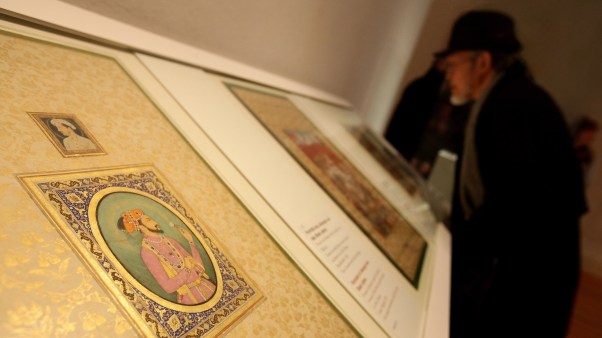It was the worst thing I had ever done as an artist. On the easel before me, in the midst of a just completed abstract painting, was a giant arrow pointing heavenward. In a moment of artistic weakness and evangelistic fervor I had brushed it in.
Why such a crudely pious statement? Frankly, it was an attempt to gratify my hunger to make the painting “authentically Christian”—an anxiety not uncommon in believing artists.
Christian painters know that the evangelical community expects their work to be obviously apologetic in content. Any deviation, whether it be a more subtle expression of the Christian faith or experimenting with contemporary styles of painting, and the artist stands accused of pursuing a frivolous career unworthy of the true disciple. It should be no surprise that this climate has strangled the creative talents of many people. Except for Georges Rouault, a Catholic, there has been no great Christian painter in our century. When painters become propagandists their art suffers. We can see this more clearly by assaying the demise of painting in the Soviet Union. What has happened there parallels in many ways what has happened to twentieth century Christian art.
Painting never has been the Soviet Union’s leading art form (the Western practice of easel painting was uncommon before the 1700s). Rather, its artists have excelled in music, ballet, and literature. But there was a period, about the time of the Revolution, when Russian painters were on the cutting edge of the avant-garde.
Cultural as well as political upheaval followed 1917—a new art for new society. Chagall and Kandinsky rushed home from their exiles to help in reshaping Soviet painting. But the foremost exponent of revolutionary art was Kasimir Malevich. He preached a radical form of abstraction called “Suprematism.”
“If one insists on judging an art work on the basis of the virtuosity of the objective respresentation,” Malevich maintained, “and thinks he sees in the objective representation itself a symbol of the inducing emotion, he will never partake of the gladdening content of a work of art.” He voided the canvas of any hint of the objective world, reducing painting to its barest essential, or “pure feeling” as he called it. This led to the cul-de-sac of abstract art—a white square on a white canvas—that Malevich painted before 1920.
Although he declared “art no longer cares to serve the state …,” his radical ideas closely paralleled the Marxist revolt. In 1920, to celebrate the anniversary of the Revolution, Malevich and his followers repainted the town of Vitebsk. Eisenstein, Russia’s preeminent film maker, described the sight: “all the main streets are covered with white paint splashed over red brick walls, and against this white background are green circles, reddish-orange squares, and blue triangles. This is Vitebsk 1920. Kasimir Malevich’s brush has passed over its walls.”
Yet for all its revolutionary fervor, abstract painting was little understood by Russia’s political leaders, and even less intelligible to the peasant masses. Artists became disillusioned with this confusion. Marc Chagall was heard to quip to a befuddled colleague, “let Marx, if he’s so wise, come to life and explain it to you.”
Lenin was perplexed but tolerant. Stalin, however, was not. A directive was issued in 1934 establishing “socialist realism” as the only accepted style of painting. The First All-Union Congress of Soviet Writers set the boundaries of socialist realism, demanding of the artist “a true, historically concrete depiction of reality in its revolutionary development. In this respect truth and historical concreteness of reality must be combined with the task of ideologically transforming and educating the workers in the spirit of socialism.” Political revolutionaries sometimes have Philistine tastes.
After this, painting died in Russia. Artists (at least the accepted ones) are now unabashed servants of the State. Even Malevich knuckled under to the dictates of the government. And his later work is a sad testimony to the atrophy that sets in when art becomes propaganda.
Recently the Metropolitan Museum of Art in New York in cooperation with the Soviet Union showed some examples of socialist realism. Such pictures as “Lenin in the Smolnyi Institute” reveal a technical ability devoid of even a modicum of creativity. Hilton Kramer, art critic for the New York Times, indicted not only the paintings, but the museum for displaying them. He wrote: “The art is mostly terrible—provincial and poor in quality even when it is not grossly ideological—and would never have been exhibited under these exalted museum auspices on aesthetic grounds alone. The show is a political act, and thus represents a corruption of the museum’s function.”
Before we judge the Russians too harshly, however, let us examine the beam in our own eye. Evangelicals do not have a Ministry of Culture, but recent Christian art in many ways resembles socialist realism. Our message is different, yet the results are remarkably similar.
A cursory glance at the paintings included in Cynthia Pearl Maus’s Christ and the Fine Arts demonstrates this. Although intended for young people, her book contains pictures that most Christians identify with and that are most frequently seen in our churches. Some are masterpieces from another age (Rubens’s “Descent From the Cross”) but others, especially as they approach our time, are mere illustrations (Sallman’s “Christ at Dawn”).
Illustrations are useful and welcome tools, but they are no substitute for art. Norman Rockwell’s pictures are fun to look at, but how many of us would compare them to the magnificent compositions of Rembrandt? The works of Sail-man and Rouault are just as far apart.
Artists are best equipped to solve the problem of how Christian values should be conveyed to modern man through painting. We must allow them the freedom to do so. If evangelicals become more flexible in their cultural tastes, and churches more supportive of the artists (after all, for centuries the Church was the major patron of the arts), Christians will once again produce truly great testimonies to the God we all worship.
Mark Marchak is a painter who lives in Brooklyn, New York.









